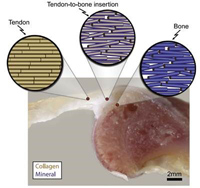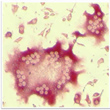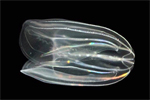Spotlight
Letter from Dr. Stephen I. Katz: NIAMS 2014 A Year of Health Multicultural Planners
Last year, as part of the NIAMS National Multicultural Outreach Initiative (NMOI), we developed A Year of Health multicultural planners to make health information about bones, joints, muscles and skin more accessible to people from underserved racial and ethnic communities.
Building on last year’s success, we created health planners for 2014 targeted to four multicultural audiences – African Americans; Hispanics/Latinos; Asian Americans and Pacific Islanders; and American Indians, Alaska Natives, and Native Hawaiians. The 2014 planners have been refreshed with new images, and have the same reminder stickers that were so popular last year for tracking medical appointments, blood tests, prescription refills and other important self-care activities.
Image: Stephen I. Katz, M.D., Ph.D.
News
Bone Loss in Spondyloarthritis Linked to Protein’s Misfolding
In contrast to normal bones, the bones of people with spondyloarthritis become damaged and deformed, causing back and hip pain, as well as other symptoms. Now, scientists at the National Institutes of Health’s (NIH) NIAMS have uncovered new clues to how these bone abnormalities occur.
Image: Osteoclasts, center. Credit: Robert Colbert, M.D., Ph.D.
 Muscle Activity Necessary for Healthy Tendon-Bone Interface Development
Muscle Activity Necessary for Healthy Tendon-Bone Interface Development
Muscle exertion is necessary to ensure the development of a functional, structurally sound connection between tendon and bone in young mice, according to recent research funded by the NIH’s NIAMS. The research was published in the journal Bone.
Image: Tendon-to-bone interface. Credit: Stavros Thomopolous, Ph.D.
With New Study, Aquatic Comb Jelly Floats Into New Evolutionary Position: Study Calls for a Shift in Understanding of How Complex Cell Types Evolved
In a study that compares the genomes of aquatic life forms, researchers have found evidence to shuffle the branches of the tree of life. For more than a century, scientists thought that complex cell types, like neurons and muscles, evolved only once, after simple animals that lack these cell types branched from the rest of animals on the evolutionary tree. A team of researchers from the National Human Genome Research Institute (NHGRI), part of the NIH, has provided new evidence from the genomic study of a ctenophore species—a comb jelly—that challenges this long-held view.
Image: Aquatic comb jelly, M. leidyi.
NIH To Fund Research Workforce Diversity Program: Awards Will Support Creative and Transformative Approaches To Prepare Students for Successful Biomedical Research Careers
The NIH is releasing three new funding opportunity announcements (FOAs) to develop approaches to engage researchers, especially from backgrounds underrepresented in biomedical sciences, and prepare them to thrive in NIH-funded research careers. The funding through the Enhancing the Diversity of the NIH-Funded Workforce program will establish a national consortium to develop, implement and evaluate approaches to encourage individuals to start and stay in biomedical research careers.
President Obama Honors Outstanding Early-Career NIH Scientists
President Obama has chosen 20 NIH scientists for this year’s Presidential Early Career Award for Scientists and Engineers (PECASE), the highest honor bestowed by the U.S. government to outstanding scientists and engineers beginning their independent careers.
NIH Names Dr. Philip E. Bourne First Associate Director for Data Science
NIH Director Francis S. Collins, M.D., Ph.D, announced the selection of Philip E. Bourne, Ph.D., as the first permanent Associate Director for Data Science (ADDS). Dr. Bourne is expected to join the NIH in early 2014.
Updated NIH Data Book Describes FY2013 Research Applications, Funding and Awards
The NIH Deputy Director for Extramural Research blogs about the NIH Data Book, which has been updated with statistics of fiscal year 2013 grant funding. Application success rates declined in 2013 to a historic low as a result of sequestration, which lowered NIH appropriations by more than 5 percent or $1.55 billion below the previous fiscal year.
PubMed Gets Interactive
The NIH’s National Library of Medicine (NLM) is bringing a new way of sharing and exchanging research information, fully integrated with the PubMed website, to a wider audience. For the last few months, NLM has been running a pilot of a commenting system for PubMed’s massive database of biomedical literature. The system, PubMed Commons, allows authors to discuss and share information through comments on article citations. Hundreds of authors have signed up as beta testers and commenters since the pilot began. While commenting will continue to be available only to authors of publications in PubMed (see this page for more details), the discussion is now viewable by the broader public.
NIH Director’s Blog
PCORnet: Meeting Clinical Trials’ Need for Speed
Comparative effectiveness research (CER) studies aim to determine what works (and what doesn’t) in the real world of clinical medicine. Such studies are essential to identify the safest, most effective ways of detecting, treating and preventing disease. Yet, both patients and researchers are often frustrated by the agonizingly slow pace at which many CER studies proceed. Under our current system, it’s often a long, costly process to identify trial sites, recruit volunteers, run the study, compile data and, finally, analyze the results. The time is ripe to revamp the way we do this.
Using Tiny Sponges To Fight MRSA
Methicillin-resistant Staphylococcus aureus bacteria, commonly known as MRSA, pose a serious public health threat, causing more than 80,000 skin, lung and blood infections and killing about 11,000 people annually in the United States. This microbe wreaks its devastation by secreting a toxin, alpha-hemolysin, that punches holes in the membrane of cells, essentially causing them to leak to death. Now, NIH-funded researchers from the University of California, San Diego have created tiny sponges capable of trapping and binding MRSA’s toxin. When these toxin-laden sponges are injected into mice, they serve as a vaccine—that is, they stimulate the animal’s immune system in a way that protects them from the toxin’s deadly impact.
Image: MRSA toxin bound to nanosponge particles glows yellow inside a mouse immune cell. The cell membrane is stained red and the nucleus is stained blue.
Credit: Liangfang Zhang Laboratory, University of California, San Diego
Other Federal News
Agency for Healthcare Research and Quality (AHRQ) Report Available for Comment Until February 10: Vitamin D and Calcium: A Systematic Review of Health Outcomes (Update)
The AHRQ Effective Health Care Program makes draft reports available to the public for comment before they are officially published. All draft reports of technical briefs, systematic reviews, and original research reports are open to public comment for a period of four weeks.
NEW PUBLICATIONS
NIH Research Matters
NIH Research Matters is a review of NIH research from the Office of Communications and Public Liaison, Office of the Director, NIH.
Arthritis Genetics Analysis Aids Drug Discovery
An international team identified 42 new areas in the human genome associated with rheumatoid arthritis. Many are already the targets of drugs approved for other conditions.
Image: Merkel cells (pink) and nerve cells (blue). Credit: Kara Marshall/Lumpkin Lab, Columbia
NIH News in Health
Read practical health information in NIH News in Health, which is reviewed by the NIH’s medical experts and is based on research conducted either by the NIH’s own scientists or by its grantees at universities and medical schools around the country.
Who Needs a Knee Replacement?
If you or someone you know is considering knee replacement, a new resource can help you understand how it works, how to prepare for surgery, and what to expect in recovery.
A Burning Issue: Handling Household Burns
Accidental burns can occur just about anywhere in your home, and they’re not always caused by fire. Take steps to prevent household burns, and learn how to treat them properly to avoid lasting problems.
MEETINGS
NIAMS Advisory Council Meeting
The NIAMS Advisory Council Meeting will be held February 11, 2014, in Building 31, 6th Floor, C Wing, Conference Room 6, NIH Campus. A meeting agenda is available here.

NIH Wednesday Afternoon Lecture Series
The NIH’s Wednesday Afternoon Lecture Series offers weekly lectures every Wednesday at 3 p.m. in Masur Auditorium, Building 10, NIH Campus. Renowned scientists from around the globe present research on a variety of topics. The lectures are Continuing Medical Education-certified, open to the public and available live via webcast.
Upcoming Lecture:
February 5, 2014
Jenny Ting, UNC School of Medicine
“The Broad Impact of NLRs on Immunity and Beyond”
NIH Science Lectures and Events Available Online
The NIH hosts a number of science seminars and events that are available online through real-time streaming video. You can watch an event at your convenience as an on-demand video or a downloadable podcast. Most events are available to all; a few are broadcast for the NIH or the U.S. Department of Health and Human Services and are marked as such. See additional details on events.
NIAMS Exhibit Schedule
The NIAMS exhibit is traveling to several events. See the schedule of health fairs and exhibits.
Image: The NIAMS Exhibit
FUNDING ANNOUNCEMENTS
NIAMS Announcements
BD2K-LINCS-Perturbation Data Coordination and Integration Center (DCIC) (U54)
(RFA-HG-14-001)
February 19, 2014
Letter of Intent Receipt Date: February 19, 2014
Application Receipt Date: March 19, 2014
Development of an NIH BD2K Data Discovery Index Coordination Consortium (U24)
(RFA-HL-14-031)
Letter of Intent Receipt Date: February 6, 2014
Application Receipt Date: March 6, 2014
Ruth L. Kirschstein National Research Service Award (NRSA) Institutional Research Training Grant (Parent T32)
(PA-14-015)
Letter of Intent Receipt Date: not applicable
Application Receipt Dates: Standard dates apply
NIH Pathway to Independence Award (Parent K99/R00)
(PA-14-042)
Letter of Intent Receipt Dates: Not applicable
Application Receipt Dates: Standard dates apply, with the first due date on February 12, 2014
Mentored Research Scientist Development Award (Parent K01)
(PA-14-044)
Letter of Intent Receipt Dates: Not applicable
Application Receipt Dates: Standard dates apply, with the first due date on February 12, 2014
Mentored Clinical Scientist Research Career Development Award (Parent K08)
(PA-14-046)
Letter of Intent Receipt Dates: Not applicable
Application Receipt Dates: Standard dates apply, with the first due date on February 12, 2014
Midcareer Investigator Award in Patient-Oriented Research (Parent K24)
(PA-14-047)
Letter of Intent Receipt Dates: Not applicable
Application Receipt Dates: Standard dates apply, with the first due date on February 12, 2014
Mentored Quantitative Research Development Award (Parent K25)
(PA-14-048)
Letter of Intent Receipt Dates: Not applicable
Application Receipt Dates: Standard dates apply, with the first due date on February 12, 2014
Mentored Patient-Oriented Research Career Development Award (Parent K23)
(PA-14-049)
Letter of Intent Receipt Dates: Not applicable
Application Receipt Dates: Standard dates apply, with the first due date on February 12, 2014
Pilot and Feasibility Clinical Research Grants in Arthritis and Musculoskeletal and Skin Diseases (R21)
(PAR-14-060)
Letter of Intent Receipt Date: Not applicable
Application Receipt Dates: April 7, 2014; July 1, 2014; November 3, 2014
NIH Common Fund Initiative Announcements
NIH Coordination and Evaluation Center for Enhancing the Diversity of the NIH-Funded Workforce Program (U54)
(RFA-RM-13-015)
Letter of Intent Receipt Date: February 18, 2014
Application Receipt Date: March 18, 2014
NIH Building Infrastructure Leading to Diversity (BUILD) Initiative (U54)
(RFA-RM-13-016)
Letter of Intent Receipt Date: February 18, 2014
Application Receipt Date: March 18, 2014
NIH National Research Mentoring Network (NRMN) (U54)
(RFA-RM-13-017)
Letter of Intent Receipt Date: February 18, 2014
Application Receipt Date: March 18, 2014
Validation and Advanced Development of Technologies for the Study of Biological Properties of Single Cells (R33)
(RFA-RM-13-020)
Letter of Intent Receipt Dates: Not applicable
Application Receipt Date: April 4, 2014
Exceptionally Innovative Tools and Technologies for Single Cell Analysis (R21)
(RFA-RM-13-021)
Letter of Intent Receipt Date: March 4, 2014
Application Receipt Date: April 4, 2014
Revisions To Add Single Cell Analysis to Active Research Projects (R01)
(RFA-RM-13-022)
Letter of Intent Receipt Date: March 4, 2014
Application Receipt Date: April 4, 2014
Revisions To Add Single Cell Analysis to Active Research Projects (U01)
(RFA-RM-13-023)
Letter of Intent Receipt Date: March 4, 2014
Application Receipt Date: April 4, 2014
Administrative Supplement to Existing NIH Directors Biomedical Research Workforce Innovation Award: Broadening Experiences in Scientific Training (BEST) (Admin Supp)
(PA-14-040)
Letter of Intent Receipt Date: Not applicable
Application Receipt Dates: March 24, 2014
Other Funding Announcements
Botanical Dietary Supplement Research Centers (P50)
(RFA-OD-14-001)
Letter of Intent Receipt Date: April 6, 2014
Application Receipt Date: June 6, 2014
Notice of Extension of Expiration Date for PA-11-180 “Research on Ethical Issues in Biomedical, Social and Behavioral Research (R01)”
(NOT-OD-14-031)
Notice of Extension of Expiration Date for PA-11-181 “Research on Ethical Issues in Biomedical, Social and Behavioral Research (R03)”
(NOT-OD-14-032)
Notice of Extension of Expiration Date for PA-11-182 "Research on Ethical Issues in Biomedical, Social and Behavioral Research (R21)"
(NOT-OD-14-033)
Notice Regarding NIH Plan to Transition From Use of USDA Class B Dogs to Other Legal Sources
(NOT-OD-14-034)
Notice of Reissuance of the Parent Research Career Development (K) Award Funding Opportunity Announcements
(NOT-OD-14-036)








